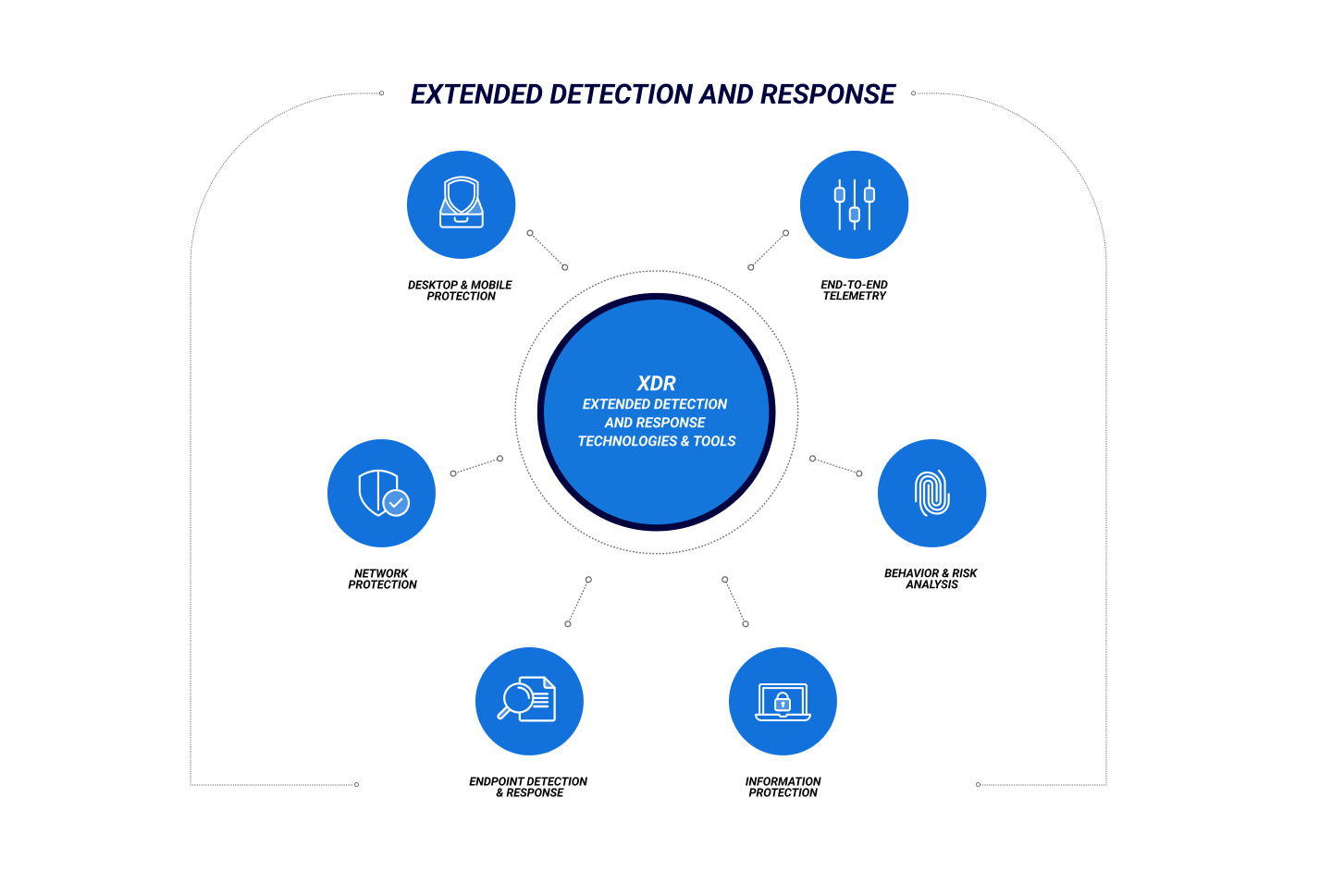What Is XDR?
Extended Detection and Response (XDR) is a unified cybersecurity solution that collects and analyzes data from multiple sources to prevent, discover, and respond to cyberattacks. XDR expands on Endpoint Detection and Response (EDR), which is limited to endpoints. In contrast, XDR identifies and addresses cyber threats across an enterprise's entire digital environment, including its network, cloud storage, applications, and endpoints.
Through XDR, Security Operations Centers (SOCs) and security teams can achieve a cohesive, holistic view of an enterprise's technology landscape for cybersecurity.

Benefits of Extended Detection and Response
According to Gartner, an XDR solution provides enterprise cybersecurity teams with:
- Improved protection, detection, and response capabilities
- Improved productivity of operational security staff
- Lower total cost of ownership (TCO)
With a complete view of all potential network and endpoint vulnerabilities, enterprise security personnel can better prevent cyber threats. If a cyberattack occurs, XDR enables faster discovery, response, and remediation, freeing up valuable resources for other business projects.
The primary value of an XDR solution is the simplicity of a combined, cohesive cybersecurity platform. XDR collects activity data across multiple security layers, including email, endpoint, server, cloud, and network. Automated analysis of this data can detect threats as they happen, which allows security teams to investigate and respond more quickly.
More XDR Benefits
- Fewer false positives and less alert fatigue
- More accurate incident response
- Clear context for remediation and analytics
- Streamlined operations and a smaller tech stack
Extended Detection and Response Components
Extended Detection and Response Features
According to Gartner, an XDR solution should include:
- Centralization of normalized data, primarily focusing on the XDR vendor’s ecosystem
- Correlation of security data and alerts into incidents
- A centralized incident response capability that can change the state of individual security products as part of incident response or security policy setting
XDR solutions encompass EDR tools for attack prevention, endpoint monitoring, automated response action, and threat hunting with dashboards and reports for visualizing data. XDR solutions unify visibility and management across endpoints, the enterprise network, and cloud-based assets.
Tip: An XDR solution should bring together intelligence about cyberattacks from internal and external sources or advanced AI and machine learning capabilities to help identify current and evolving cyberthreats.
XDR enhances an SOC's ability to deal with cyberattacks by:
- Detecting potential security incidents at endpoints and other vulnerable areas
- Identifying actual cyberthreats versus non-incidents
- Auto-responding to incidents by either containing or remediating based on custom rules
XDR solutions can also improve cybersecurity by:
- Sharing threat intelligence with component security products to provide efficient, unified blocking of threats
- Aggregating weak signals from multiple components into stronger signals of a cyberthreat
- Automatically correlating and confirming alerts
- Contextualizing relevant data for alert triage
- Centralizing and prioritizing response and remediation steps
Although EDR is an effective defense against cyberattacks, XDR expands on EDR with additional protections at the network, servers, cloud, and application levels.
Both EDR and XDR involve continuous monitoring, threat detection, and automated response to cyber threats, but EDR's scope is limited to endpoints—XDR is more comprehensive. By unifying detection and analysis of cyberthreats against an organization's network, cloud workspaces, and endpoints, XDR can more effectively defend against cyberattacks than EDR alone.
Like EDR, Security Information and Event Management (SIEM) is a cybersecurity practice that provides SOCs with incident data for cyber threat monitoring and response. SIEM combines Security Event Management (SEM) from event data analysis with Security Information Management (SIM), which collects and analyzes log data. SIEM focuses on alerts generated at the application and network hardware levels.
Although both XDR and SIEM pull and analyze data from multiple sources, XDR includes more cybersecurity functionality such as EDR. In addition, an XDR solution is also more likely to focus on cyber threat detection and response, whereas an SIEM platform may have limited remediation functionality.
FAQ
What is XDR?
Extended Detection and Response (XDR) is a unified cybersecurity solution that collects and analyzes data from multiple sources to prevent, discover, and respond to cyberattacks.
What is an XDR system?
An XDR system or solution encompasses tools for endpoint attack prevention, monitoring, automated response action, and threat hunting with dashboards and reports. It also includes features for securing cloud storage, email, and apps. XDR solutions unify visibility and management across endpoints, the enterprise network, and cloud-based assets.
How does an XDR system work?
An XDR system secures enterprise networks by detecting potential security incidents at endpoints and other vulnerable areas, identifying actual cyberthreats versus non-incidents, and auto-responding to incidents by containment or remediation based on custom rules.
Is XDR better than EDR?
Although Endpoint Detection and Response (EDR) is an effective defense against cyberattacks, Extended Detection and Response (XDR) expands on EDR with additional protections at the network, servers, cloud, and application levels. Both EDR and XDR involve continuous monitoring, threat detection, and automated response to cyberthreats, but EDR’s scope is limited to endpoints and XDR is more comprehensive.